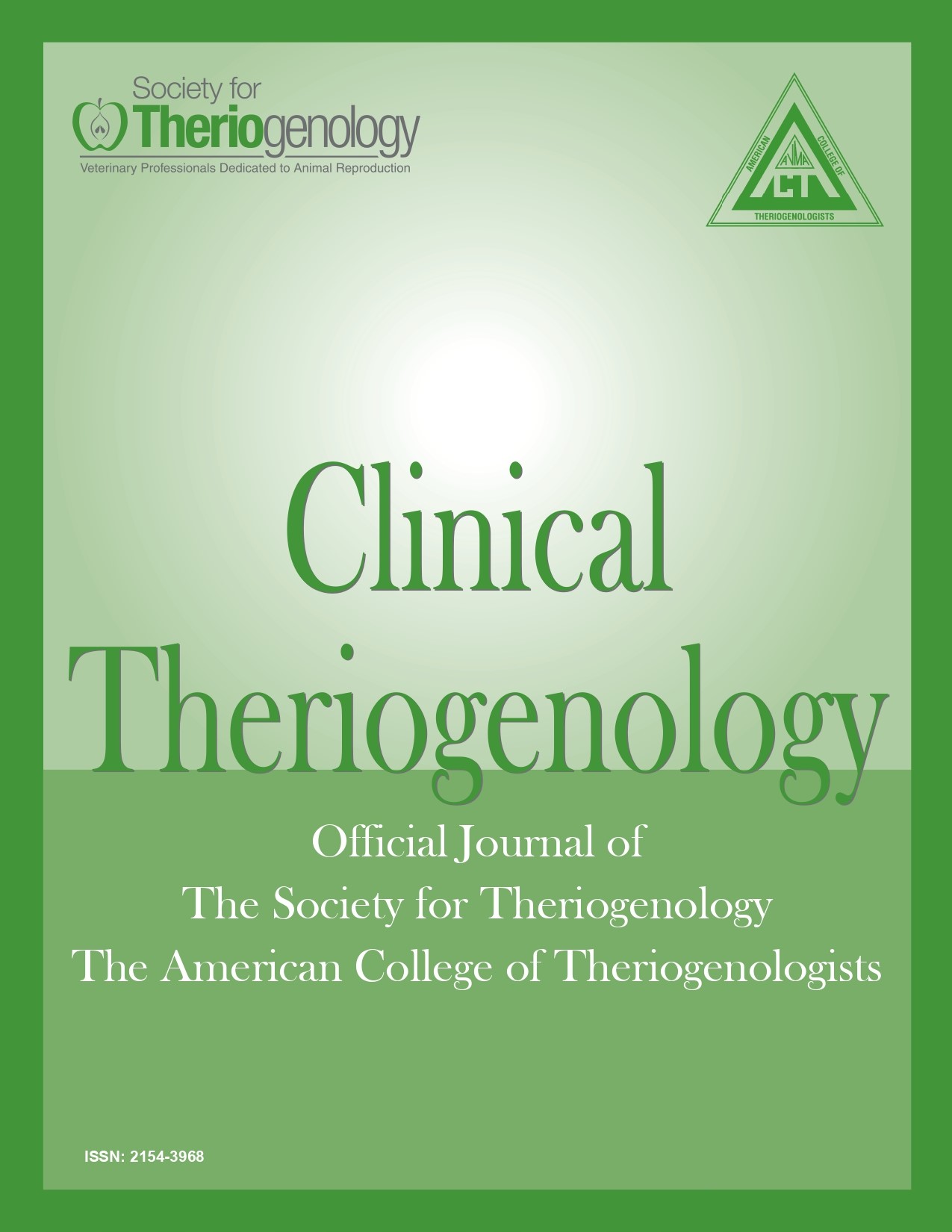Double cervices in a Gypsy Vanner mare
Abstract
A 7-year, purebred Gypsy Vanner, maiden mare was presented with abnormal cervical tissue that was detected during prebreeding examination. External vulvar examination, transrectal and ultrasonographic examination of uterus, and internal vaginal vault and cervical examination (via speculum and endoscopy) were conducted. Karyotype analysis included sex chromosome study with dual-color fluorescence in situ hybridization and polymerase chain reaction for SRY gene. Mare had normal 64,XX karyotype with no evidence of mosaicism. Two distinct, patent, cervical ora separated by a frenulum, leading to a single uterine body, were observed. It was recommended to avoid breeding because of dystocia risk. To the authors’ knowledge, this is the first reported case of this nature in a mare.
Downloads
References
2. Golan A, Langer R, Bukovsky I, et al: Congenital anomalies of the Müllerian system. Fertil Steril 1989;51:747–755. doi: 10.1016/S0015-0282(16)60660-X
3. Volkmann D, Gilbert R: Uterus bicollis in a Clydesdale mare. Equine Vet J 1989;21:71. doi: 10.1111/j.2042-3306.1989.tb02093.x
4. Blue MG: A uterocervical anomaly (Uterus bicorpor bicollis) in a mare and the manual disruption of early bilateral pregnancies. N Z Vet J 1985;33:17–19. doi: 10.1080/00480169.1985.35137
5. Murcia-Robayo RY: An unusual case of uterus didelphys in an infertile mare with mosaic X-chromosome aneuploidy. Reprod Biol Endocrin 2018;2:22–25.
6. Raudsepp T, Chowdhary BP: Construction of chromosome specific paints for meta- and submeta-centric autosomes and the sex chromosomes in horse and their use to homologous chromosomal segments in donkey. Chromosome Res 1999;6:103–114.
7. Janečka JE, Davis BW, Ghosh S, et al: Horse Y chromosome assembly displays unique evolutionary features and putative stallion fertility genes. Nat Commun 2018;9:2945. doi: 10.1038/s41467-018-05290-6
8. Raudsepp T, Chowdhary BP: FISH for mapping single copy genes. Methods Mol Biol 2008;422:31–49. doi: 10.1007/978-1-59745-581-7_3
9. Machado DA, Ontiveros AE, Behringer RR: Mammalian uterine morphogenesis and variations. In: Gridley T, Oxburgh L, eds. Current topics in developmental biology. Vol. 148. Cambridge, MA: Academic Press; 2022, pp. 51–77.
10. Spencer TE, Hayashi K, Hu J, et al: Comparative developmental biology of the mammalian uterus. In: Schatten G, ed. Current topics in developmental biology. Vol. 68. Cambridge, MA: Academic Press; 2005, pp. 85–122.
11. Card C: Congenital abnormalities of the cervix in mares. Equine Vet Ed 2012;24:347–350. doi: 10.1111/j.2042-3292.2011.00363.x
12. Favoretto SM, daSilva EG, Menezes J, et al: Reproductive system of Brown- throated Sloth (Bradypus variegatus, Schinz 1825, Pilosa, Xenarthra): anatomy and histology. Anat Histol Embryol 2016;45:249–259. doi: 10.1111/ahe.12193
13. Heinonen PK: Longitudinal vaginal septum. Eur J Obstet Gynecol Reprod Biol 1982;13:253–258. doi: 10.1016/0028-2243(82)90106-X
14. Gormley RK, Crabtree JR: Female caudal reproductive tract abnormalities. Equine Vet Edu 2021;33:411–414. doi: 10.1111/eve.13307
15. Albu CC, Albu DF, Muşat AR, et al: The crucial role of SRY gene in the determination of human genetic sex: 46, XX disorder of sex development. Rom J Morphol 2019;60:1311–1316.
16. Schimpf MG, Milesi MM, Luque EH et al: Evaluation of development of the rat uterus as a toxicity biomarker. In: Palmeira CMM, de Oliveira DP, Dorta DJ, eds. Toxicity assessment methods and protocols. Methods in Molecular Biology, Vol. 2240. Clifton, N.J.: Springer Protocols; 2021, pp. 103–117.

This work is licensed under a Creative Commons Attribution-NonCommercial 4.0 International License.
Authors retain copyright of their work, with first publication rights granted to Clinical Theriogenology. Read more about copyright and licensing here.





